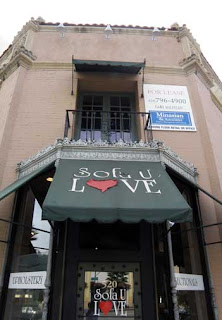Capture California, the Game-2012
Adventure: 051, Site 157 – Oak
of the Golden Dream
California Landmark Number: 168
Team: Thing One, Thing Two
Date: October 6, 2012
Location:
Latitude:
34° 22.696′ N
Longitude: 118° 33.83′ W
Address: I-5 and Lyons Ave, Newhall, CA
Description:
This plaque is sort of a double find
for us and it seems to be fitting that it commemorates the first gold
find in California in 1842. When we found the previous plaque on the
first commercial liquid gold (oil) refinery in California, there
right beside it, up from the Burger King, was the plaque telling
about the first gold strike in California. There is not anything
remaining of the gold strike and the plaques are located on a busy
street. You have to be willing to step into traffic to read the
plaques. But we did and lived.
After writing and researching this, I
think that team Thing One, Thing Two found the lazy person's plaque
for the Oak of the Golden Dream. After seeing some sites, we probably
stopped at a California Landmark plaque for the Oak. But the real oak
is 6 miles down the road. By the way, we are glad that we were mistaken. Somehow, it seemed wrong that such an oak would have been cut down to make a Burger King.
NO. 168 OAK OF THE GOLDEN DREAM - Francisco López
made California's first authenticated gold discovery on March 9,
1842. While gathering wild onions near an oak tree in Placerita
Canyon he found gold particles clinging to the roots of the bulbs.
The San Fernando placers and nearby San Feliciano Canyon were worked
by Sonoran miners using panning, sluicing and dry washing methods.
Lopez's find predated James Marshall strike at Sutter's Mill by six
years.
Location: Site: Placerita Canyon State and
County Park, Placerita Canyon Rd, 4.6 mi NE of Newhall (Los Angeles)
Plaque: SE corner I-5 and Lyons Ave, Newhall
From Waymarking about the other plaque commemorating the gold
find:
It is purported that Jose Francisco De Gracia Lopez fell asleep
under an oak in Canon de los Encinos (Live Oak Canyon) and dreamt of
gold. When he awoke, he was hungry and dug up some wild onions at the
base of a nearby tree with his pocket knife. Clinging to the roots of
the onions were nuggets of gold. Lopez and his associates scoured the
nearby riverbanks and discovered more pockets of gold. They took
their findings to nearby Los Angeles and relayed word of their
discovery to their native Mexico City. The gold was assayed by the
Philadelphia Mint and found to be .926 fine. Hundreds of prospectors
from Los Angeles and Sonora, Mexico flocked to Live Oak Canyon, which
was renamed Placerita Canyon. The word "placer" is of
Spanish origin and means surface deposits of sand or gravel
containing gold. From 1842 to 1847, the miners culled some 1,300
pounds of gold from Placerita. This is the first recorded
authenticated find of gold in the area and that which is believed to
have kicked off the monumental California Gold Rush in 1842.
Additionally, Lopez’s was the first attempt at establishing a
mining claim. Historians disagree on whether significant gold finds
preceded that of Lopez, but his is surely the most legendary.
The
oak tree beneath which Lopez took his fateful nap is now a California
Historical Landmark, the Oak of the Golden Dream, and is located
within the boundaries of the Placerita Canyon Park. It is the
featured site of this earthcache and is a short, pleasant walk down
the paved Heritage Trail.
References:
Overall Landmark References:















 Thing Two had a lot to think about when
it came to the Fresno County Court House. After the move from
Millerton in 1875, we had a gorgeous court house. The picture
reminded you of our state capital. In the pictures of historical
downtown Fresno, the Court house seemed to anchor the town. Many
building had already been torn down that were the Victorian in
nature. The courthouse remained connecting us to the pioneer days of
Fresno. In 1962 our County Board of Supervisors voted to tear down
the courthouse. A citizen group fought the action to tear down the
court house. Even with public support against the supervisors’
decision, they refused to listen to their constituents. In the next
election all supervisors up for election were voted out of office.
But we lost a gorgeous building and a bit of our past. The building
was deemed to be a danger because of earthquakes so it would only
take 2 hours to demolish this building. It took over 8 hours to tear
down the courthouse.
Thing Two had a lot to think about when
it came to the Fresno County Court House. After the move from
Millerton in 1875, we had a gorgeous court house. The picture
reminded you of our state capital. In the pictures of historical
downtown Fresno, the Court house seemed to anchor the town. Many
building had already been torn down that were the Victorian in
nature. The courthouse remained connecting us to the pioneer days of
Fresno. In 1962 our County Board of Supervisors voted to tear down
the courthouse. A citizen group fought the action to tear down the
court house. Even with public support against the supervisors’
decision, they refused to listen to their constituents. In the next
election all supervisors up for election were voted out of office.
But we lost a gorgeous building and a bit of our past. The building
was deemed to be a danger because of earthquakes so it would only
take 2 hours to demolish this building. It took over 8 hours to tear
down the courthouse.


























